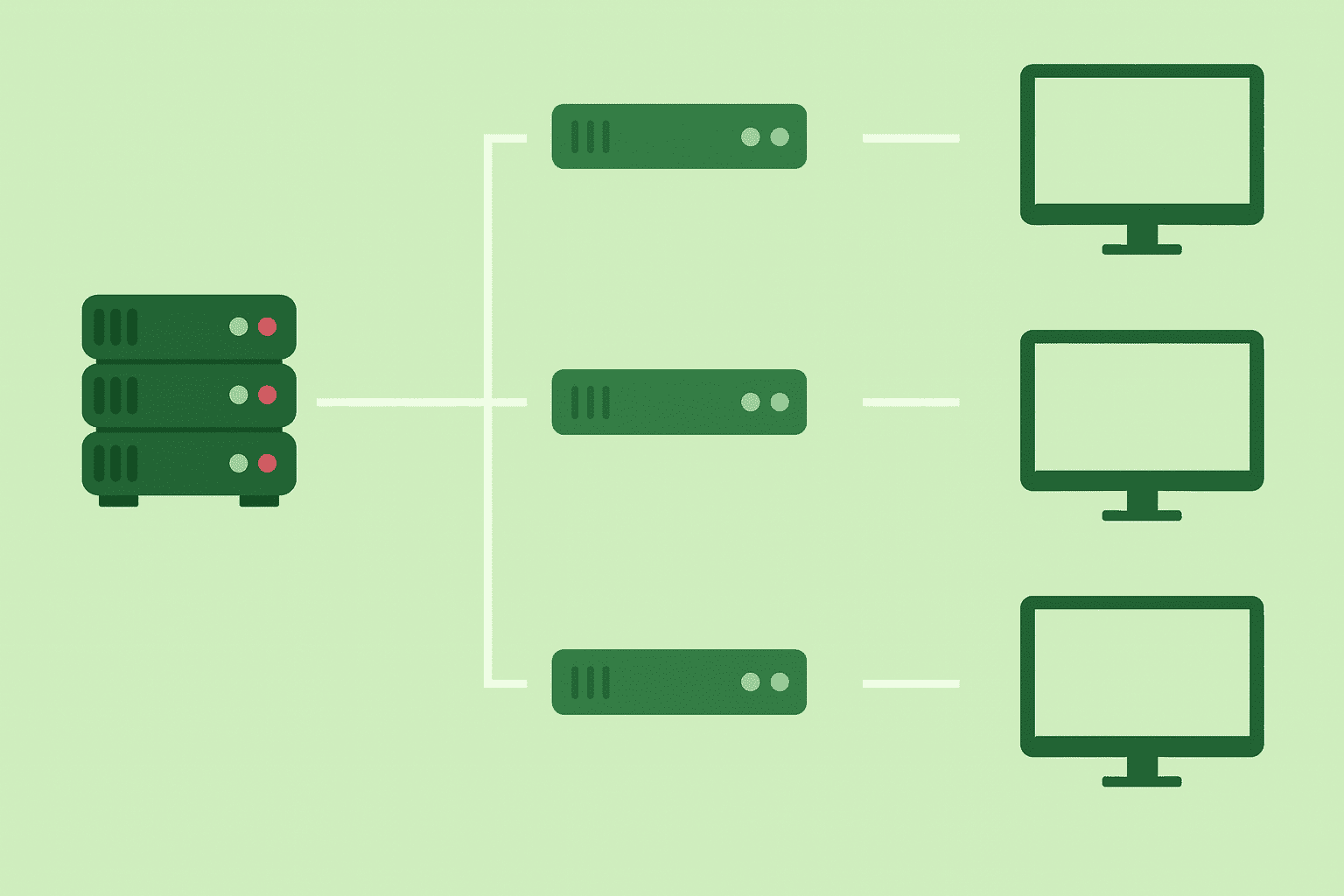
This article gives you the tools you need to set up a simple PostgreSQL backup using built-in tools like pg_dump, pg_basebackup, and rsync. It clearly explains ...
3v-Hosting Blog
9 min read
Gradually, from the early 2000s to the present day, virtual private servers have quietly become one of the most flexible tools in the modern infrastructure arsenal. They occupy an intermediate position between virtual (shared) hosting and dedicated servers, as they are isolated enough to perform serious work tasks, but at the same time simple and accessible enough to experiment without fear. Many IT professionals and entrepreneurs have at least one VPS as a platform for experimentation, a test environment, a VPN node, or even the core of a commercial product. Understanding the essence and principle of VPS hosting helps to compare all these roles and easily determine the purpose of purchasing a VPS server.
In this article, we will look at several real-world uses for VPS, how some teams apply them in business, and why this hosting model remains one of the most economical building blocks for a huge number of online projects.

Before moving on to real-world use cases, it is worth explaining the basics and defining some terms. We have previously published an article on this topic, but we will repeat ourselves a little here.
So, a VPS server is a virtual machine with dedicated resources, located on a physical host and isolated from other virtual machines. The abbreviation VPS stands for Virtual Private Server, and in everyday tasks it behaves almost like a real server, meaning you get root access, install any software, configure the system, and deploy services as you see fit. As a result, developers get resources dedicated solely to them and full control over them, but without having to pay for the cost of renting an entire physical server.
Although the concept sounds simple enough, its value becomes clearer when we consider the question of what a VPS is using real-life examples.
In general, virtual private servers can be used to build fairly complex infrastructure projects, flexible, isolated environments that can be easily and quickly scaled from small personal projects to full-fledged production platforms.
Many people ask:
“What is VPS hosting used for?”
The short answer is almost anything that does not require specialized equipment. But let's try to find a more complete answer to this question below.
This is the most familiar scenario. When a virtual hosting plan reaches its limit, switching to a VPS is a natural upgrade. Developers get customizable server configurations, the ability to deploy Docker containers, and the freedom to choose their stack. This versatility explains why VPS servers are most often used for reliable hosting with a high level of isolation and predictable performance.
A typical and obvious example is a fast-growing online store that requires Redis caching, background processes, and custom firewall configuration. None of this works correctly on virtual hosting, but a VPS handles it without any problems.
Ask any DevOps engineer what a VPS is used for in practice, and they will say that it is a safe place to test new ideas and hypotheses. Want to test a new option for logging into the site admin panel? Launch a small VPS and test it. Need a temporary PostgreSQL instance to test new indexes? Same solution. Lightweight disposable servers solve a huge number of problems in everyday engineering work.
Small businesses often don't have specialized IT equipment, but still need a variety of internal tools. VPS is a convenient and compact solution for hosting CRM systems, inventory management platforms, analytics dashboards, and mail gateways. Since VPS is completely isolated, when configured correctly, you don't have to worry about security, and by adding monitoring and alerts, you'll always know if something is wrong with your system. The ability to scale your server as your workload increases is particularly convenient. This practical flexibility demonstrates once again that the only limitation to using VPS is your lack of imagination.
If we delve even deeper into the subject, the question of what a VPS is used for can be expanded almost indefinitely. With full root access, an isolated environment, and predictable resources, a virtual server becomes an excellent platform for the most unusual and specific tasks. Here are a few more examples that go slightly beyond standard use.
Many teams set up OpenVPN or WireGuard on a VPS to create secure remote access to corporate resources. This approach is suitable for both small groups that need secure access to internal services and companies that care about data privacy. Your own VPN allows you to control work logs, traffic management, encryption policies, and entry points. In addition, any configuration changes can be made independently, without relying on a third-party service, which makes this option much more flexible and predictable.
Some companies prefer to keep auxiliary workflows away from production. GitLab Runners, GitHub Actions self-hosted runners, or Jenkins agents are perfectly suited for a separate VPS. This approach reduces the risk of accidental load on the main infrastructure and allows you to configure a unique execution environment (for example, the required versions of Docker, Python, or Node.js) and provides isolation between different processes. In addition, such a VPS can be easily scaled if the pipeline starts to handle heavier tasks such as container assembly, static analysis, testing, or deployment.
Lightweight multi-user servers, Discord bots, Telegram chat bots, analytics workers, and tiny API services all fit perfectly within the capabilities of even the smallest VPS. Many developers raise separate microservices for specific tasks, such as payment processing, image generation, webhooks, or task queues. This approach provides complete independence from external constraints, ease of debugging, and the ability to migrate the project to another platform at any time. Entrepreneurs often start with one such small server and then scale the architecture by adding new micro-applications on separate VPSs or combining them into a single system.
In summary, VPS hosting is used for tasks and projects ranging from small modular services to full-fledged software and hardware complexes that require the highest level of reliability.
To better understand where VPS fits among other types of server infrastructure, it is useful to compare it with virtual (shared) hosting and dedicated servers. The table below shows the key differences that help you make a quicker decision when planning a project.
Table – Comparison of VPS, Shared Hosting, and Dedicated Servers
| Parameter | Shared Hosting | VPS | Dedicated Server |
|---|---|---|---|
| Resource Isolation | Low: the server is shared by many clients | Medium: guaranteed resources and an independent environment | Full: the hardware belongs to a single user |
| Level of Control | Limited settings, no root access | Full root access, flexible system configuration | Maximum control over the entire hardware platform |
| Performance | Depends on the load from other websites on the server | Predictable, resources are reserved for the virtual machine | Maximum performance, limited only by the physical hardware |
| Scalability | Limited by hosting plans | Flexible: quick adjustments of CPU, RAM, and storage | Requires hardware replacement or upgrade |
| Cost | The most budget-friendly option | Mid-range, optimal for most projects | The most expensive due to renting physical hardware |
| Best For | Personal sites, small projects | Medium and growing projects, web applications, test environments, business services | High-load applications, large stores, corporate systems |
Modern cloud platforms promise their potential customers convenience above all else. But as soon as you start to dig deeper, it becomes clear that using any cloud comes with a multi-level pricing policy, vendor lock-in, and limited customization options. VPS, on the other hand, offers a clean, predictable environment where performance depends solely on your configuration skills. For engineers who value transparency, this simplicity is a big advantage, because it is always clear what the VPS server is used for and what tasks its resources are currently involved in.
Another key point when using a VPS is that any virtual server can be easily moved, cloned, backed up, or restored anywhere. Yes, this is reminiscent of the now familiar Docker containers, but for projects that do not fit into serverless or containerized workflows, this flexibility is of great value.
Before deploying any project, it is useful to first assess its requirements. Analytical pipelines associated with high CPU load will likely require a fairly powerful server with multiple dedicated processor cores. The same problem applies to tasks that require a lot of computation, such as working with video, graphics, or AI, for which GPU servers are absolutely necessary.
At the same time, small websites, business dashboards, or small microservices are ideal candidates for hosting on a VPS.
Most teams or young businesses start with a single server, experiment, and gradually expand their infrastructure. The low barrier to entry allows you to quickly and cheaply create an MVP and test business hypotheses without large initial costs.
Although we briefly mentioned which tasks are better suited to other types of hosting, let's now take a closer look at this issue.
Although virtual servers are versatile and suitable for most tasks, there are scenarios in which VPS is no longer the optimal choice. It is important to understand these limitations in advance to avoid bottlenecks in performance, cost, or compliance with licensing requirements.
Machine learning systems, especially those that use TensorFlow, PyTorch, or large language models, require powerful computing resources and specialized accelerators. VPS typically provides only regular CPUs, without dedicated GPUs. For such workloads, it is more efficient to use bare-metal servers or specialized cloud nodes.
Graphics accelerators are rarely available in a virtualized environment and are often limited in bandwidth. Any rendering, video processing, or model inference tasks will run slowly or unstably. If your project is critically dependent on CUDA or other GPU technologies, VPS is also not a suitable platform.
Some enterprise solutions, including 1C in server mode, require a strictly licensed Windows Server. Such infrastructure can be set up on a regular VPS, but with legal and technical limitations. It is much easier and more reliable to use a dedicated server or specialized Windows hosting with the correct licensing.
VPS usually runs on expensive NVMe/SSD arrays. Allocating several terabytes for it is impractical, as the price increases faster than the benefits. If the project involves storing large datasets, media archives, logs, or backups, it is better to consider dedicated servers or object storage.
This division helps to better understand whether a virtual server is suitable for a specific project and also helps to avoid situations where the infrastructure begins to limit the growth of the application.
A virtual server is used for hosting websites and applications, running VPNs, deploying test environments, CI/CD, business tools, microservices, bots, and auxiliary services. It is a universal platform for tasks that require isolation and flexible configuration.
A VPS provides fixed dedicated resources—CPU, RAM, and disk space—that are independent of other users. In the cloud, resources are allocated dynamically, and the price can increase depending on the load. A VPS offers predictability and control, while the cloud offers scalability and additional services.
Minimal Linux or Windows skills are desirable, such as working with the terminal, configuring programs, and basic security. However, many providers offer ready-made images, control panels, and automated configurations that greatly simplify administration.
Yes. You can host multiple websites, APIs, bots, or internal tools on one machine if you have enough resources. It is important to monitor the load, use containerization or virtual environments, and control security.
For most stores, VPS is a more cost-effective and stable solution. It allows you to flexibly configure caching, databases, background tasks, and optimization for a specific platform. Cloud services are justified for high loads, autoscaling, and complex distributed architecture.
Yes, if you use ready-made configurations or a control panel. For complex projects, it is better to hire a specialist, but for small websites and pet projects, VPS is often easy enough to maintain.
If you are wondering what VPS is used for, the real answer is simple: for everything you need, as long as it fits into a virtual machine. From websites to VPN tunnels, from development sandboxes to commercial services, VPS remains one of the most versatile tools for IT professionals and entrepreneurs.
Understanding what VPS is and how it works is just the beginning. The real value lies in how creatively you apply it to solve practical problems. Whether you're launching new business ideas or experimenting with cloud stacks, a virtual private server gives you the freedom to create, destroy, recreate, and scale your infrastructure however you want.

SOLID principles help create flexible, scalable, and maintainable code. We break down SRP, OCP, LSP, ISP, and DIP with examples and practical recommendations.

HTTP 503 (Service Unavailable) means that your server is overloaded or undergoing maintenance. Find out what causes this error, how to fix it, and how to preven...

Manage your VPS and websites easily with the Ispmanager control panel. Create domains, databases, and backups in one click, monitor performance, and secure your...